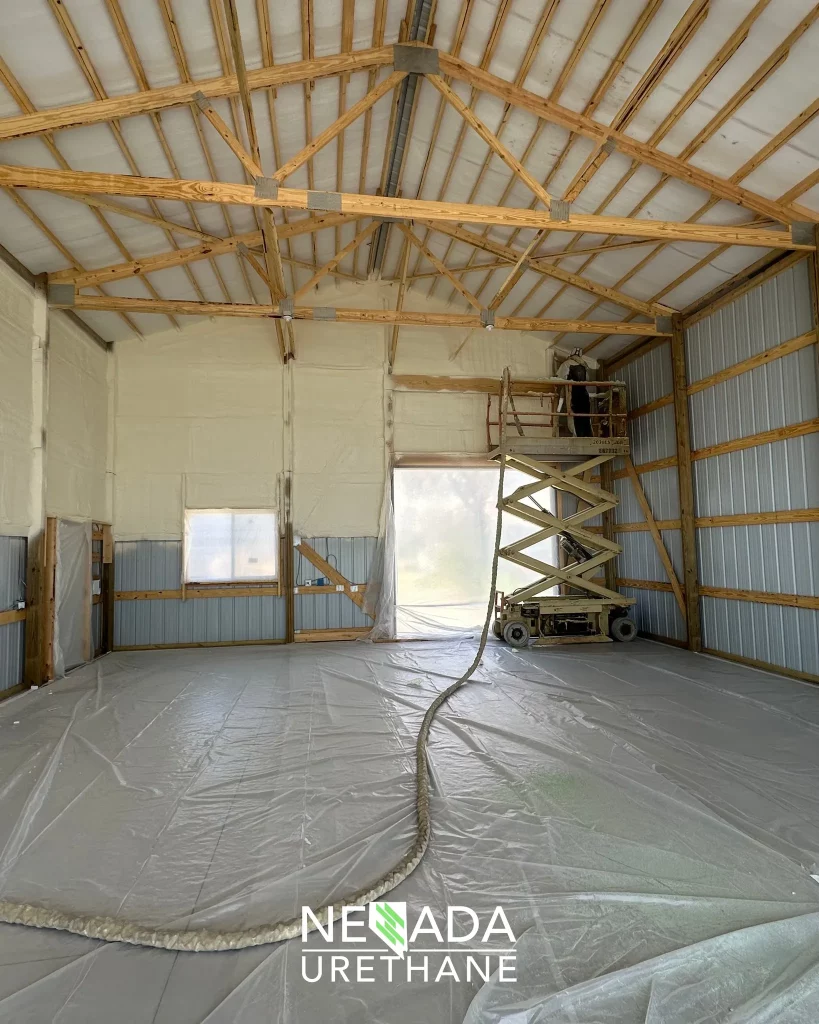
Spray foam insulation helps reduce roof leaks in Deeth homes by sealing gaps, cracks, and seams that allow water intrusion. Its closed-cell structure acts as both an air barrier and moisture barrier, preventing water from entering through vulnerable areas in roofs, particularly those exposed to wind-driven rain or ice dam formation.
The insulation expands on contact, filling irregular voids and forming a continuous, monolithic layer. This integration reduces the likelihood of water penetrating weak spots commonly found in traditional insulation setups. Spray foam also adheres directly to roof decking and rafters, strengthening structural integrity while eliminating air pathways that contribute to condensation and leaks. For added protection and energy efficiency, many homeowners also consider applying a Roof Coating to complement spray foam and enhance the longevity of their roofing system.
This guide explains how spray foam insulation works in Deeth’s high desert climate, how it compares with other materials, and what technical performance data support its leak-prevention benefits. Information is based on practical experience with installation and repair jobs throughout northeastern Nevada.
Unlike batt or blown-in insulation, spray foam forms a seamless layer that covers joints, flashing transitions, and protrusions. These areas are common leakage points when exposed to fluctuating temperatures or wind-driven precipitation.

Closed-cell spray foam adds rigidity to roof assemblies, which helps minimize shifting that leads to cracks. It bonds to plywood, OSB, metal, and tile underlayment, acting as a secondary water-resistant layer.
Bonus Tip: In older homes, spray foam often compensates for warped decking or aged fasteners, reducing the chance of structural leaks without needing full roof replacement.
| Property | Closed-Cell Spray Foam | Fiberglass Batts | Blown-In Cellulose |
|---|---|---|---|
| Water Absorption | < 0.03% (ASTM D2842) | High | Moderate |
| Air Impermeability | Yes (ASTM E283) | No | Low |
| R-Value per inch | ~6.5 | ~3.5 | ~3.2 |
| Structural Reinforcement | Yes | No | No |
| Installation Method | Spray-applied, expands | Manually installed | Blown into cavities |
| Ideal for Roof Leak Control | Yes | No | Low |
Deeth’s semi-arid climate brings significant daily temperature swings, freeze-thaw cycles, and gusty wind events. These conditions often loosen roofing nails and degrade sealants over time.
Spray foam creates a buffer zone against these fluctuations by reducing thermal bridging and air intrusion, which are key contributors to moisture migration. In snow-prone seasons, it also minimizes ice dam risk by maintaining attic temperatures more uniformly.
| Consideration | Spray Foam Insulation | Conventional Materials |
|---|---|---|
| Leak Prevention Effectiveness | High | Low to Moderate |
| Maintenance Needs | Low | Medium to High |
| Longevity | 20-30 years | 10-15 years |
| Initial Cost | Higher upfront | Lower upfront |
| ROI via Energy + Repairs Saved | High over long term | Moderate to Low |
Bonus Tip: Deeth homeowners often recoup spray foam installation costs faster due to combined savings in both leak repairs and heating efficiency.
Yes, especially when decking is intact. It improves sealing without major reconstruction.
Most residential attics in Deeth can be completed in 1-2 days depending on square footage.
If installed properly with dry substrates, it prevents moisture buildup. Poor prep can lead to problems.
Minimal. Annual inspection for mechanical damage or UV exposure (if exposed) is recommended.
For roof leak prevention in Deeth and surrounding areas, spray foam insulation provides reliable performance in extreme local weather. Nevada Urethane brings practical field experience and regional expertise to every installation.
Phone: (775) 397-2820
Email: [email protected]
Spray foam covers entire surfaces and insulates, while caulking only seals joints or cracks. Foam is more comprehensive.
No. It must be applied beneath the roof deck or to interior attic surfaces.
Some Nevada energy programs may offer incentives. Eligibility varies by project type and provider.
Yes. It dampens airborne sound transmission, especially in roof cavities.
Foam can be cut away and replaced, but removal should be done by professionals to avoid structural damage.